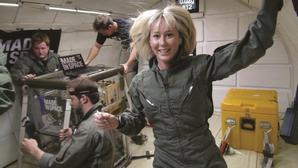| |
By Jennifer Kalish
EDITORIAL INTERN
Published: August 23, 2013 2:52 pm ET

Image By: Made in Space
The Made in Space Inc. team runs tests during a reduced-gravity flight
After almost three years of trial and error, NASA is planning to launch the world's first zero-gravity-capable 3-D printer into space as early as June 2014.
"The ability to design on your laptop and print out the tool you need while you're on these long trips is extraordinarily useful," said David Steitz, public affairs officer for space technology at NASA headquarters. "If they can prove that the printer can work in zero gravity and manufacture useful parts, the potential is amazing."
Like many of us here on Earth, it's fairly common for astronauts in orbit to lose or break important tools and products. However, instead of making a quick trip to the hardware store for new tools, astronauts living on the International Space Station must often wait several months before receiving any replacement parts.
That, along with the many other challenges of space exploration, inspired NASA to invest about $1.4 million into Made in Space Inc., a manufacturer out of Moffett Field, Calif., to develop a space-capable 3-D printer for use on the ISS and beyond.
"The 3-D printer, as it's estimated right now, could replace I think 30 percent of the small parts and tools on the International Space Station," said Grant Lowery, marketing and communications manager for Made in Space. "If a part gives out or if they just need a tool they don't have on hand, they could actually create the tool or part on the station."
Since the project's inception in 2010, Made in Space has tested a variety of 3-D printing technologies on a series of microgravity flights through NASA's Flight Opportunities program.
The test flights helped guide the design of the company's current prototype, which uses extrusion additive manufacturing to build layered objects out of a mixture of ABS and more advanced, space-qualified thermoplastics.
The prototype performed well in the parabolic and suborbital test flights, and is now ready for its final test, aboard the ISS.
Still, the device's accuracy in microgravity printing was difficult to perfect.
"There are a lot of unique challenges," Lowery said. "In a microgravity environment you're going to encounter the movement of any parts within the printer, and a part being off even by a fraction of a millimeter could destroy the prints."
Similarly, the thermal properties of the extrusion process can vary between microgravity and zero gravity, he said.
If the printer proves successful in space next year, NASA hopes to expand the use of 3-D printing beyond the ISS.
"You know when we go up to the space station and back we can do so in a relatively easy amount of time," Steitz said. "But when you're going out to Mars, it's nine months each way just to get there. So if you're going to be doing a mission that long and you're halfway there and then you realize, oh we forgot a wrench, well you can't go home, you can't go back for it, you've only got what you've got."
NASA is also researching in-space 3-D printing of other materials, like food and satellites.
"Launch costs can be $100 million to $500 million for a spacecraft," said Steitz. "Whereas if I just print what I need in space, I not only don't have to worry about the launch costs because I can just print it up there, but then I also am not constrained by design."
While the 3-D printing of food and satellites in space are just concepts at this point, they are not far-fetched ones. In fact, NASA recently gave a $100,000 grant to a research company in Austin, Texas, to develop a 3-D food printer that could help sustain astronauts on a mission to mars.
"NASA is a collection of people who tend to be visionary," Steitz said. "Just because it doesn't exist doesn't mean it can't." | |
